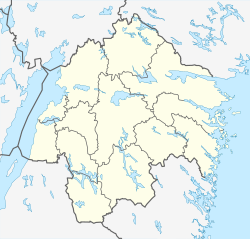Norrköping
| Norrköping | |
|---|---|

The Strykjärnet building on the Motala River
|
|
| Nickname(s): Peking, Little Manchester | |
| Coordinates: 58°36′N 16°12′E / 58.600°N 16.200°ECoordinates: 58°36′N 16°12′E / 58.600°N 16.200°E | |
| Country | Sweden |
| Province | Östergötland |
| County | Östergötland County |
| Municipality | Norrköping Municipality |
| Area | |
| • Total | 35.68 km2 (13.78 sq mi) |
| Population (31 March 2016) | |
| • Total | 137,326 |
| • Density | 2,446/km2 (6,340/sq mi) |
| Time zone | CET (UTC+1) |
| • Summer (DST) | CEST (UTC+2) |
| Website | norrkoping.se |
Norrköping (Swedish pronunciation: [²nɔrːɕøːpɪŋ]) is a city in the province of Östergötland in eastern Sweden and the seat of Norrköping Municipality, Östergötland County. The city has a population of 87,247 inhabitants in 2010, out of a municipal total of 130,050, making it Sweden's tenth largest city and eighth largest municipality.
The city is situated by the mouth of the river Motala ström, at Bråviken, an inlet of the Baltic Sea. Water power from the Motala ström and the good harbour were factors that facilitated the rapid growth of this once industrial city, known for its textile industry. It has several nicknames such as: "Sweden's Manchester", "Peking" and "Surbullestan" (Surbulle [sour bun] was a local nickname for the textile workers, and stan is short for Staden, which means The City or The Town in Swedish).
The city has medieval foundations by settlers around the Norrköping twin city with Linköping Motala stream estuary, who used the falls and rapids to power their mills. The stream was also full of fish such as salmon. Exact dates are uncertain, but there are mentions of a church in the 12th century. It was dedicated to Saint Olaf, Norway's patron.
The first trace of the city's name is from 1283, when wealthy David Appelgren, Lord of Östergötland, donated his rights of salmon fishing to the Skänninge monastery. The town is estimated to have received city status in the early 14th century, although no written documents exist prior to a document from 1384. This document, signed by Albrekt of Sweden is stored in the city archive today. Köping means there was a market there.
...
Wikipedia


